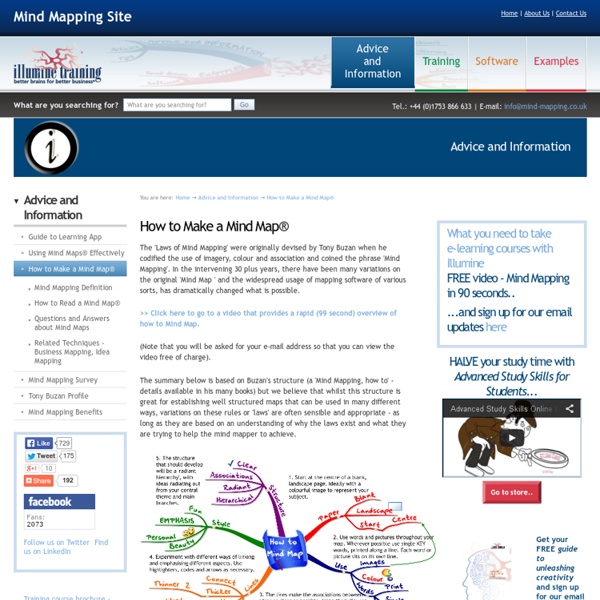Tech breakthroughs are reshaping retail shopping in the USA
SANTA CLARA, Calif. – Nola Donato has seen the future of retail, and it is in a Magic Mirror. The Intel scientist has designed a high-tech mirror that shows how clothes look on a consumer who simply stands in front of an LCD monitor. Parametric technology simulates body type and how fabrics fit — based on weight, height and measurements.
Organiser son dispositif de formation avec le mindmapping
Dans le cadre de mon activité j’ai eu la responsabilité de mettre en oeuvre divers processus de formations (le PIM Passeport Internet et Multimédia, le travail collaboratif avec les méthodes et outils web 2.0)°. Pour concevoir l’architecture de ces dispositifs je me suis appuyé sur une méthode d’ingénierie jumelée avec la carte heuristique. En utilisant la technique du Mindmapping pour cartographier le dispositif d’action j’ai gagné du temps notamment dans la recherche et la formulation de nouvelles idées. La carte m’a fait gagné en efficacité dans l’analyse des besoins, la rédaction et la gestion des contenus (objectifs de formation, les évaluations, le public cible, la stratégie pédagogique etc. …).
frontline: the persuaders: neuromarketing
But 30 years after the commercials debuted, neuroscientist Read Montague was still thinking about them. Something didn't make sense. If people preferred the taste of Pepsi, the drink should have dominated the market.
Neuroscience of Free Will
Neuroscience of free will is the part of neurophilosophy that studies the interconnections between free will and neuroscience. As it has become possible to study the living brain, researchers have begun to watch decision making processes at work. Findings could carry implications for our sense of agency and for moral responsibility and the role of consciousness in general.[1][2][3] Relevant findings include the pioneering study by Benjamin Libet and its subsequent redesigns; these studies were able to detect activity related to a decision to move, and the activity appears to begin briefly before people become conscious of it.[4] Other studies try to predict activity before overt action occurs.[5] Taken together, these various findings show that at least some actions - like moving a finger - are initiated unconsciously at first, and enter consciousness afterward.[6]
5 for available in French
NovaMind software are pleased to announce the immediate availability of NovaMind 5 in French. With this release, NovaMind 5 for Mac is now available in English, French, Spanish, and German, and NovaMind 5 for Windows is available in English, French, Spanish, Simplified Chinese, Traditional Chinese and German. The updated release is available immediately through the download link on the NovaMind web site, or through the normal update mechanism for customers who have purchased through the NovaMind online store (either Windows or Mac), and will be available for Mac App Store customers as soon as it has gone through the Apple approval procedures.
Emotional Intensity
Do you consider yourself an emotional person? If a potential friend candidly described you that way to your face, would you be flattered or disturbed? Compared to most people you know, are you stronger in the intensity and range of your feelings, milder, or somewhere in between? Whereas for centuries astute observers of the human condition have noted that people vary remarkably in this dimension — it's been the theme of many great novels — only recently have psychologists come to understand that this difference is already apparent on our first day of postnatal existence — and continues strikingly unchanged ever after. Emotional Intensity clearly plays a major role in love relationships, yet has oddly been all but ignored professionally. The vast realm of our feelings is clearly experienced differently by people across cultures.
Top 10 Deadliest Rampage Killers
Crime We’ve seen plenty of movies, books and documentaries on serial killers, but not so many on those who are so efficient and deadly that they can murder dozens of people in a single day. Murder sprees seem to have become more prominent over time – notably the tragedy in Norway, which is as recent as July 2011. This evil act will no doubt happen again thousands of times in the future. What I have presented in this list is no more than the proverbial tip of the iceberg.
Top 7 Sources of Stress and Their Remedies
Will Joel Friedman, Ph.D. Updated: Sep 29th 2011 Hans Selye coined the term "stressor" to indicate any event, condition or state of affairs that demands a change, whether desired or not. Both hypoactivity or doing too little (i.e., couch potato syndrome) and hyperactivity or doing too much, too quickly with little or no limits or boundaries Selye considered sources or "distress," or what most people shorten to simply call "stress."
10 fresh ways to boost your energy now
Must. Stay. Awake. Yes, it's the 3 o'clock mantra. And who hasn't mumbled it while fighting off midday yawns and drooping eyes?
Classification of Emotions
Psychologists have yet to fully tackle the question “How many emotions do we have?” Part of the difficulty is because our experiences are so complex and involve so many different factors, so distinguishing one emotion from another is a lot like drawing lines of sand in the desert. It can be hard to determine where one emotions ends or another begins.



